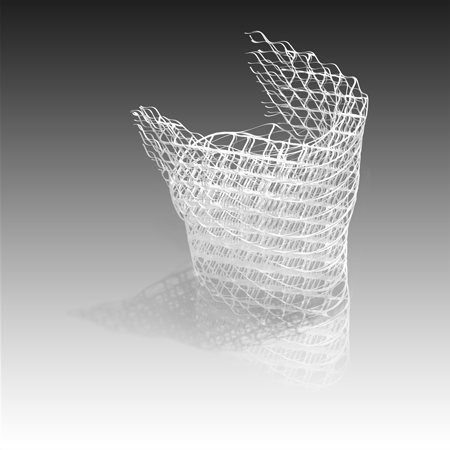Another chair from Tokyo-based Nendo: the Diamond chair is based on the atomic structure of diamonds.
The chair is made using a form of 3D printing called selective laser sintering (SLS).
The chair is printed in two pieces, one inside the other, which then snap together.
The photos here show the chair emerging from the SLS machine.
Nendo will create an installation using the same structure for automobile brand Lexus at the Museo della Permanente in Milan during the furniture fair next month.
See more Nendo projects in our recent stories:
Meguro office space
Cabbage Chair
Here's some more information from Nendo:
--
Lexus L-finesse – elastic diamond Milan Design Week 2008
An installation at Museo della Permanente, the art museum, during Milan Design Week 2008. We want visitors to experience the ultimate fusion of opposite elements that is “L-finesse”, the design ideal behind the premium Lexus automobile brand.
Using the atomic structure of diamonds as our motif, we have designed a “strong but flexible” structure that will fuse the existing opposing concepts of “strong yet solid” and “weak yet flexible”. The artificial structure is tangible but transparent; it seems complex but also natural and uncomplicated. Like our diamond chair, which uses the same structure, the installation expands and contracts as though it is breathing. The pillars quiver and contract in response to human movement, creating a spatial experience in which people and things seem in sync.
We created such a structure through powder sintering rapid prototyping technology that uses a laser to transform polyamide particles into a hard mold based on 3D CAD data. The RP technology let us add thickness where users needed support, and to carve away the material into a thinner, more flexible and responsive thickness in places where users want comfort, allowing one material to serve multiple purposes.
There is a limit to the size of an object a RP machine can produce, so we designed the chair in two pieces that snap together like a puzzle, and attached them after each piece had hardened. This not only let us control cost and production time, but also, since the pieces are cast at the same time, eliminating the problem of parts not fitting together exactly during assembly because any shrinkage or distortion due to heat occurs at the same time and the same rate.
Since it only takes five to six days to produce, a manufacturer would not have to worry about keeping it in stock, and overseas orders could be filled by sending data oversaes for production on a local RP machine, drastically cutting shipping time and cost. In other words, the diamond chair project showed us that in the near future, we may well solve problems that have long plagued the furniture industry.
Lexus L-finesse – elastic diamond
16 – 20 April 2008
Museo della Permanente, Milano

